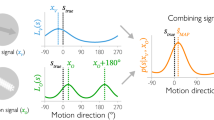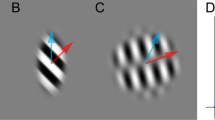Abstract
Visual motion is processed by neurons in primary visual cortex that are sensitive to spatial orientation and speed. Many models of local velocity computation are based on a second stage that pools the outputs of first-stage neurons selective for different orientations, but the nature of this pooling remains controversial. In a human psychophysical detection experiment, we found near-perfect summation of image energy when it was distributed uniformly across all orientations, but poor summation when it was concentrated in specific orientation bands. The data are consistent with a model that integrates uniformly over all orientations, even when this strategy is sub-optimal.
This is a preview of subscription content, access via your institution
Access options
Subscribe to this journal
Receive 12 print issues and online access
$209.00 per year
only $17.42 per issue
Buy this article
- Purchase on Springer Link
- Instant access to full article PDF
Prices may be subject to local taxes which are calculated during checkout





Similar content being viewed by others
References
Nakayama, K. Biological image motion processing: a review. Vision Res. 25, 625–660 (1985).
Adelson, E. H. & Movshon, J. A. Phenomenal coherence of moving visual patterns. Nature 300, 523– 525 (1982).
Albright, T. D. Direction & orientation selectivity of neurons in visual area MT of the macaque. J. Neurophysiol. 52, 1106– 1130 (1984).
Movshon, J. A., Adelson, E. H., Gizzi, M. S. & Newsome, W. T. in Experimental Brain Research Supplementum II: Pattern Recognition Mechanisms (eds. Chagas, C., Gattass, R. & Gross, C.) 117– 151 (Springer, New York, 1986).
Morgan, M. J. Spatial filtering precedes motion detection. Nature 355, 344–346 (1992).
Watson, A. B. & Ahumada, A. J. in Motion: Perception & Representation (ed. Tsotsos, J. K.) 1–10 (Association for Computing Machinery, New York, 1983).
Adelson, E. H. & Bergen, J. R. Spatio-temporal energy models for the perception of motion. J. Opt. Soc. Am. A 2, 284–299 (1985).
Heeger, D. J. Model for the extraction of image flow. J. Opt. Soc. Am. A 4, 1455–1471 (1987).
Grzywacz, N. M. & Yuille, A. L. A model for the estimate of local image velocity by cells in the visual cortex. Proc. R. Soc. Lond. B Biol. Sci. 239, 129– 161 (1990).
Simoncelli, E. P. & Heeger, D. A model of neuronal responses in visual area MT. Vision Res. 38, 743–761 (1998).
Derrington, A. M. & Suero, M. Motion of complex patterns is computed from the perceived motions of their components. Vision Res. 31, 139–149 (1991).
Kersten, D. Statistical efficiency for the detection of visual noise. Vision Res. 27, 1029–1043 ( 1987).
Watson, A. B. & Turano, K. The optimal motion stimulus. Vision Res. 35, 325–336 (1994).
Levinson, E. & Sekuler, R. The independence of channels in human vision selective for direction of movement. J. Physiol. (Lond.) 250, 347–366 ( 1975).
Watson, A. B., Thompson, P. G., Murphy, B. J. & Nachmias, J. Summation and discrimination of gratings moving in opposite directions. Vision Res. 20, 341–347 (1980).
Dobkins, K. R. & Teller, D. Y. Infant contrast detectors are selective for direction of motion. Vision Res. 36, 281–294 (1996).
van Trees, H. L. Detection, Estimation, and Modulation Theory Part III (Wiley, New York, 1971).
Acknowledgements
P.S. was supported by an NIH training grant, D.C.K. was supported by a grant from the NIH and E.P.S. was supported by a Sloan Fellowship, an NSF CAREER grant and the Sloan Program in Theoretical Neurobiology at New York University.
Author information
Authors and Affiliations
Corresponding author
Rights and permissions
About this article
Cite this article
Schrater, P., Knill, D. & Simoncelli, E. Mechanisms of visual motion detection. Nat Neurosci 3, 64–68 (2000). https://doi.org/10.1038/71134
Received:
Accepted:
Issue Date:
DOI: https://doi.org/10.1038/71134
This article is cited by
-
Assessment of visual function in blind mice and monkeys with subretinally implanted nanowire arrays as artificial photoreceptors
Nature Biomedical Engineering (2023)
-
Prediction-for-CompAction: navigation in social environments using generalized cognitive maps
Biological Cybernetics (2015)
-
A saliency-based bottom-up visual attention model for dynamic scenes analysis
Biological Cybernetics (2013)
-
More is not always better: adaptive gain control explains dissociation between perception and action
Nature Neuroscience (2012)
-
Motion illusions as optimal percepts
Nature Neuroscience (2002)



